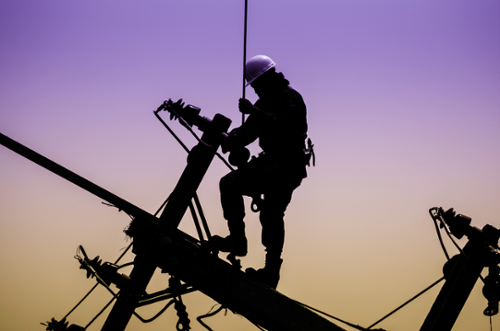
Thousands of miles of power lines deliver electricity to more than 26 million Texas customers in cities, suburbs, and rural communities. However, these power lines present serious safety hazards to workers whose equipment may come in contact with them. The Bureau of Labor Statistics reports that exposure to electricity resulted in 2,250 work-related injuries and 165 deaths in the U.S. in 2019. Fortunately, with proper training and the following procedures, power line-related injuries and deaths are preventable.
1 Locate and identify hazards.
Look for overhead power lines. Select safe job site locations with ample power line clearances for equipment and materials. Many power lines are buried underground. Contact a utility locator service or the Texas Railroad Commission at 811 at least two full business days before digging if the task involves any excavating.
2 De-energize power lines.
Always assume all overhead power lines are energized. Call the utility company to determine the line’s voltage and to discuss de-energizing and grounding or shielding the lines before performing any work near power lines.3 Work at a safe distance.
A safe working distance depends on the voltage of the power lines. Always maintain a distance of at least 10 feet from overhead lines and more than 10 feet if the voltage to ground is over 50 kilovolts (50,000 volts). The higher the voltage, the greater the distance that is needed between the lines and the workers.
4 Wear personal protective equipment (PPE).
Employers need to provide employees with free PPE for protection from electrical hazards. Depending on the job task performed, PPE when working near power lines includes safety glasses, face shields, hard hats, insulated boots, rubber gloves with leather protectors, insulating sleeves, and flame-resistant clothing to reduce the risk of electrocution.
5 Use insulated protective equipment.
Crews should use ladders made of wood or other non-conductive materials as needed, such as line hoses, rubber hoods, rubber blankets, and insulating live-line tools. Never rely solely on insulated equipment for protection.
6 Use extreme caution around trees or when moving equipment.
Watch for power lines when putting up scaffolding, framing a building, painting, pruning, or picking fruit. Trees conduct electricity, so take extra caution when working with trees around overhead power lines. Equipment carried by workers – such as metal or non-metallic ladders, paint equipment with extensions, and pieces of building materials – can hit live lines, creating a path through workers’ bodies. When using cranes, boom trucks, dump trucks, concrete pumpers, or other equipment capable of extending vertically or horizontally, ensure that no part of the load or line gets closer than 20 to 50 feet to power lines. Never allow a dump truck to move forward or backward with a raised bed when power lines are nearby. Call 911 and the local utility company if equipment contacts a power line.
7 Stay away from downed power lines.
Downed power lines can energize other nearby objects, such as fences, water pipes, bushes, trees, buildings, and telephone, television, or fiber optic cables. Even maintenance hole castings and reinforcement bars (rebar) in the pavement can become energized by downed wires. Ensure workers are trained never to approach fallen power lines.
8 Know when to move and when to stay.
If equipment comes into contact with power lines, but there is no threat of fire or power-line strikes, stay put and remain inside the equipment until the power company de-energizes the circuit. If fire or power-line strikes present an immediate threat, jump as far away from the equipment as possible. Keep both feet together to avoid landing in power ripples with different voltage. Do not walk, but shuffle, away without removing either foot from the ground. Do not let the body touch the equipment and the ground at the same time to avoid electrocution.
9 Never touch an electrocuted worker.
A worker who tries to touch or grab another worker who is receiving an electrical shock can become part of the electric circuit and sustain personal injuries or death. If an employee is electrocuted stay away and warn other to stand back at least 35 feet. Call 911 immediately.
10 Know workers’ rights.
Speak out if there are on-the-job safety concerns. Contact OSHA at 1-800-321-OSHA (6742).
For more information on power line safety, download DWC’s free Power Line Safety Fact Sheet in English or Spanish or OHSA’s Controlling Electrical Hazards booklet. DWC Safety Training Specialists are also available to answer questions or to provide customized power line safety training. Contact safetytraining@tdi.texas.gov or 1-800-242-7031, option 2.
